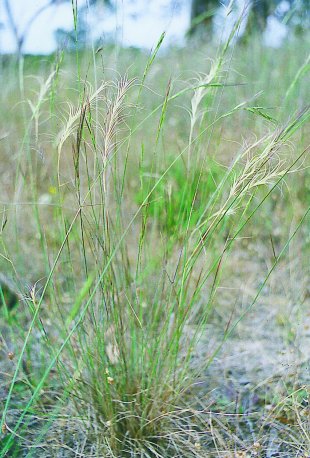
Common wheatgrass
SCIENTIFIC NAME: Elymus scaber
CATEGORY: C3 perennial
IDENTIFICATION TIPS
- Loosely tufted, cool season, short-lived perennial to 1m tall
- Leaves typically have a half twist; leaf sheaths are hairy and auricles are present
- Flag leaf (leaf directly below the seed head) is long and sticks out at a right angle
- Seedhead is a narrow spike to 25cm long; spikelets (not/little overlapping) with many awned florets; awns are straight when young and curved when mature
- Flowers late winter to early summer
CLIMATIC & SOIL REQUIREMENTS
- Is usually a minor component in open or shaded pastures
- Grows on most soil types; frost and shade tolerant; moderately drought tolerant
GRAZING & NUTRITIONAL VALUE
- Moderate to high grazing value
- Digestibility ranges from 63-90 %
- Crude protein 10-36%
MANAGEMENT STRATEGIES
- Produces high quality, palatable green feed in the cooler months on fertile soils in moister areas
- On shallower soils and drier western areas, it tend to have harsher leaves and is of lesser value
- Generally only a short lived plant, but can recruit well from seed if needed
- Growth is better under increased soil fertility and increased grazing pressure (if not selective)
- Often preferentially grazed, but is avoided after it runs to head in spring
- Rotational grazing to reduce selective grazing and providing strategic rests in spring to allow flowering and seed set will aid persistence
- Seed can be direct drilled at 5-20mm deep using a cone seeder in autumn
SIMILAR PLANTS
- Soft brome (Bromus spp.) leaves are very hairy
- Wallaby grass (Austrodanthonia spp.) and weeping grass (Microlaena stipoides) do not have twisted leaves

(Young plant: L McWhirter)

